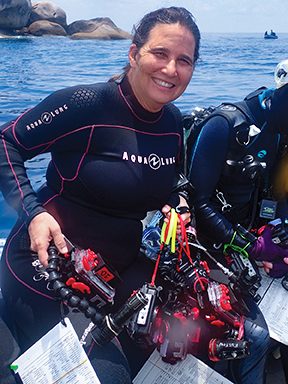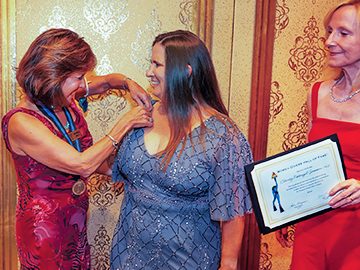Christy Pattengill-Semmens, Ph.D., dan kekuatan ilmu pengetahuan warga

Kampung halaman: Phoenix, Arizona
Bertahun-tahun Menyelam: 34
Tujuan Menyelam Favorit: Little Cayman is special because of the conservation work our team has done through the Grouper Moon Project and the time I’ve spent there with my family.
Mengapa saya menjadi Anggota DAN: Menyelam di seluruh dunia bersama REEF dan melakukan penelitian konservasi di lapangan berarti memiliki dukungan dari DAN sangat penting untuk kesehatan, keselamatan, dan ketenangan pikiran bagi seluruh keluarga kami.
DI PERSIMPANGAN PENYELAMAN, conservation, science, and education, you’ll find marine biologist and citizen science innovator Christy Pattengill-Semmens, Ph.D. As co-executive director of the nonprofit Reef Environmental Education Foundation (REEF), she oversees the Volunteer Fish Survey Project, one of the world’s largest and longest-running marine life sightings programs. The project aims to engage divers and snorkelers to collect valuable data on fish populations.
Untuk mengajari orang-orang cara mengidentifikasi apa yang mereka lihat di lautan, Pattengill-Semmens berkeliling dunia memimpin ekspedisi penyelaman edukasi sambil mengumpulkan data survei ikannya sendiri dan mendorong orang lain untuk melakukan hal yang sama. Dalam perjalanan ini, ia terkadang ditemani oleh suaminya, Brice, seorang ilmuwan perikanan dan sesama ahli identifikasi ikan, serta ketiga anak mereka yang sangat menyukai laut: Gracie, 19 tahun, Tatum, 16 tahun, dan Emery, 14 tahun, yang semuanya adalah penyelam.
Survei Ikan dan Kebetulan
Ketertarikannya pada dunia alam pada awalnya membuat Pattengill-Semmens tertarik untuk mempelajari lautan, dan pada kelas empat SD dia tahu bahwa dia ingin menjadi ahli biologi kelautan. Dia menghabiskan musim panasnya di sekolah menengah dengan menghadiri perkemahan ilmu kelautan di California di Catalina Island Marine Institute, di mana dia mendapatkan sertifikasi selamnya.
Dia mencatat lebih banyak waktu di bawah air di Catalina sambil menyelesaikan gelar sarjana biologi di University of Southern California dengan membantu proyek penelitian untuk mempelajari agresi pada ikan damselfish. Dia mendokumentasikan perilaku bersarang ikan garibaldi untuk menentukan seberapa sering mereka mengusir ikan lain dari tempat bertelur atau kebun ganggang. Mengamati para petani ganggang yang penuh semangat dan berwarna oranye cerah ini adalah pengalaman pertamanya terjun ke dunia pengamatan ikan. Setelah ribuan kali menyelam, ia masih terpesona dengan perilaku ikan.
Sebagai persyaratan untuk jurusan ilmu lingkungan, ia magang di Key Largo, Florida, bersama The Nature Conservancy, di mana ia membantu menguji coba protokol survei yang pada akhirnya menjadi Proyek Survei Ikan Relawan REEF.
“At first I didn’t know any Caribbean fish,” Pattengill-Semmens said. “I had never been to the Keys, and I was the guinea pig to see if someone with minimal experience could learn to collect meaningful data. We were writing down all the fish we saw, and the colorful, cacophonous coral reefs overwhelmed and amazed me.”
Melakukan survei REEF pertama kali pada tahun 1993 terbukti menjadi pengalaman yang mengubah hidup, dan musim panas yang dihabiskan Pattengill-Semmens sebagai pekerja magang membentuk lintasan karier dan seluruh hidupnya. Setelah mulai mengerjakan program doktoralnya di Texas A&M University, ia diundang untuk melakukan perjalanan penelitian ke Flower Garden Banks National Marine Sanctuary (FGBNMS) yang baru saja diresmikan. Sekarang, sebagai penggemar ikan, ia mengubah fokus doktoralnya dari meneliti invertebrata yang hidup di lumpur menjadi mempelajari kumpulan ikan di cagar alam tersebut.
She coordinated several research cruises each year filled with citizen scientist volunteers eager to collect data in an unexplored place. In 1996 she was honored as the FGBNMS Volunteer of the Year for her work expanding educational opportunities and increasing awareness of the sanctuary’s resources.
Her research also opened the door for collaboration between the National Oceanic and Atmospheric Administration (NOAA) Office of National Marine Sanctuaries and REEF; after completing her doctorate in zoology, she was hired as REEF’s first staff scientist. In addition to staying in contact with REEF, she also kept in touch with fellow intern Brice, and they married in 1998.
Konservasi dalam Aksi
For more than two decades, Pattengill-Semmens has directed the Volunteer Fish Survey Project’s expansion from its roots in the Caribbean to tropical and temperate seas worldwide. The project now includes 10 survey regions. She develops educational and training materials for each region, including fish identification courses, ID guides for use in the field, and online learning tools.
She also facilitates incorporating data from REEF’s marine sightings database into resource management, policy, and scientific literature. “These data, collected by recreational divers and snorkelers, have an impact on marine conservation and ocean science,” she said, “and this information would not exist otherwise.”
REEF data have been an important source of information on the status and population trends of Florida’s endangered Atlantic goliath grouper. By helping to verify juvenile habitats, identify recovery patterns, and document the positive effect the species has on reef systems, this information helps state agencies assess the impact of reopening the goliath grouper fishery.
Dia dan Brice juga merupakan ilmuwan utama untuk Grouper Moon Project, sebuah upaya sains konservasi yang sukses yang telah menyatukan pemerintah, ilmuwan, dan perikanan untuk menyelamatkan ikan kerapu Nassau yang terancam punah di Kepulauan Cayman. Kini di tahun ke-20, proyek ini dianggap sebagai cetak biru konservasi spesies yang terancam punah. Untuk pekerjaan mereka dalam proyek ini, mereka dinobatkan sebagai Selam Scuba Pahlawan Laut di tahun 2019.
Pattengill-Semmens attributes the Grouper Moon Project’s success largely to its collaborative nature. “Nonprofit, academic institutions, government, local businesses, the general public, and the fishing community all came together,” she said, “and through collaboration and everyone’s passion and dedication, we were able to achieve this amazing conservation success story. It’s inspiring because it provides hope that this can be done in other places.”
Kegembiraan dalam Penemuan
Pattengill-Semmens is passionate about the power of citizen science to shape an individual’s perspective and affect conservation. “Citizen science provides a meaningful connection to nature, whether you’re diving in the ocean or walking through a forest,” she said. “You gain a sense of purpose by contributing to something bigger than just you.”
The thrill of seeing something new, such as a rare or unusual fish, is one of the most exciting parts of citizen science. As any experienced fish surveyor or birder knows, as your sightings list increases, so do the time and effort it takes to find a species you’ve never seen before. Her list totals more than 2,200 different fish species, and one that she hopes to someday add to that count is the weedy sea dragon. “Even the people who have done thousands of surveys still have more to discover,” she said.
Aside from the excitement of seeing a new fish, some of Pattengill-Semmens’ most cherished memories are the opportunities she and her family have had to be in the field together. They typically spend several weeks in Little Cayman each winter to research the Nassau grouper spawning. Last summer they traveled to Costa Rica with a group of REEF citizen scientists to collect fish survey data and participate in other eco-activities such as birdwatching.
“We are lucky to be part of a great, supportive community,” she said, “and because of that, we never felt like we had to choose between having a family and being field biologists.”
Untuk merayakan prestasinya dalam menyelam, ilmu pengetahuan, dan konservasi, Pattengill-Semmens dilantik ke dalam Women Divers Hall of Fame (WDHOF) pada tahun 2021. Dia juga menjabat sebagai anggota dewan pengawas untuk WDHOF dan Institut Perikanan Teluk dan Karibia. Dia berharap dapat terus menginspirasi orang untuk terlibat dan belajar tentang dunia di sekitar mereka.
“One of the biggest challenges in conservation today is not only raising awareness about issues but also getting people to feel like they can make a difference,” she said. “That’s why involvement in citizen science projects like REEF’s are so important. It creates a connection to nature and empowers divers and snorkelers.”

Jelajahi Lebih Lanjut
Saksikan Christy Pattengill-Semmens mendiskusikan ilmu pengetahuan warga dan konservasi laut dalam video ini.